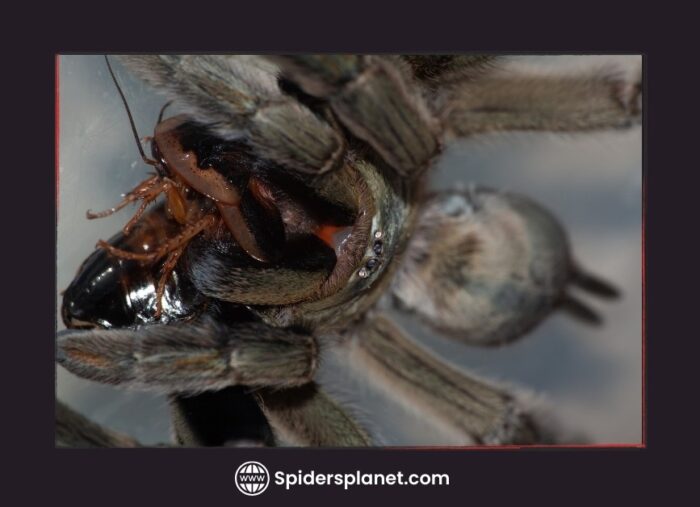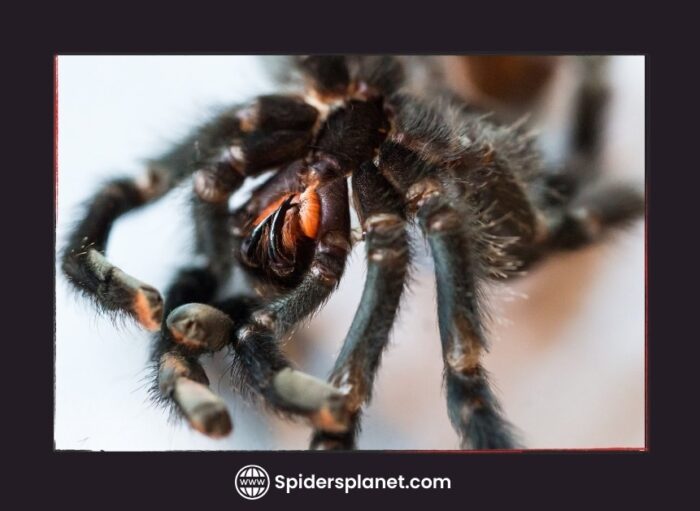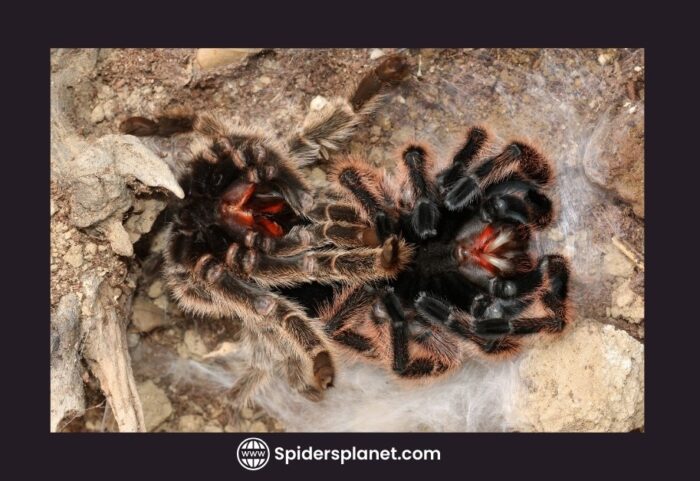Tarantulas typically do not eat their molt, the shed exoskeletons left behind after molting.
Although occasional nibbling on certain parts, such as the soft and membranous areas like the book lungs or abdomen, may occur, if they can’t find enough food in their surroundings, full consumption is generally rare.
In captivity, most tarantulas don’t eat their molt because they have enough food and water.
Arachnids and insects, in contrast to mammals or birds, grow by periodically shedding their exoskeletons in a process known as molting.
Tarantulas, with their unique molting method of carefully unzipping their old skin, add a fascinating dimension to the world of eight-legged creatures.
Now, what becomes of this leftover skin, this ghostly twin? Do tarantulas, these eight-legged beings, consume their own discarded exoskeleton?
For those keeping tarantulas as pets, understanding molting is crucial. Approximately 85% of arthropod deaths occur during this phase, often due to injuries or difficulties shedding the old exoskeleton.
Discover the frequency of tarantula molting, its importance, and the necessary precautions. This guide offers essential insights into your spider’s molting process.
Let’s find out what really happens when a tarantula sheds its skin, and is it true that tarantulas eat their own molt?
Tarantula Molting:
What is Molting?
Molting, scientifically termed ecdysis, is the phenomenon where spiders, insects, and arachnids shed their exoskeletons, the tough outer covering safeguarding their bodies.

Think of it as outgrowing your clothes, but instead of changing into new ones, these creatures literally burst out of their old skin.
Fascinating Facts about Molting:
- Certain animals, such as tarantulas, undergo molting as many as 10 times in their lifetime, marking crucial stages of growth and development.
- Molting poses a risk to the animal, as they become soft and susceptible during this period, making them more prone to potential dangers.
- While some animals engage in molting to recycle nutrients, it is less common among spiders like tarantulas, who typically do not eat their own molt.
Why Do Tarantulas Molt Process?
Tarantulas, like other arthropods such as insects and crustaceans, face a unique challenge with their non-growing, hard exoskeletons.
To cope with their non-expanding hard exoskeletons, tarantulas undergo a process called molting.
Here are the reasons behind why tarantulas molt:
Growth: Tarantulas have rigid exoskeletons that do not expand. Molting allows them to discard the too small exoskeleton and create a larger one, accommodating their internal growth.
Repair: In cases of damage, molting enables tarantulas to replace a compromised exoskeleton with a fresh, healthy one, repairing any injury or wear and tear.
Regeneration: Certain tarantula species can even regenerate lost limbs during molting. The process involves shedding the damaged limb in the old exoskeleton and gradually regrowing it in the new one.
Remember, when tarantulas molt, it is about shedding their old skin for a fresh start and facilitating essential aspects of their life cycle, and remember tarantulas do not eat their molt.
How Do Tarantulas Molt? Tarantula Molting Stages:
The molting process in tarantulas is a captivating yet intricate and delicate period for these creatures. Here’s a breakdown of the 5 key stages of tarantula molting:
1- Premolt: What are the Tarantula Premolt Signs?
The premolt stage in tarantulas, lasting from a few days to several weeks, involves noticeable physical and behavioral changes like a plump abdomen, darkened coloration, lethargy, and loss of appetite.
During this period, the tarantula focuses on forming its new exoskeleton, often ceasing eating and reducing activity.
Some species spin a protective web mat during this time as an additional adaptation.
2- Detachment Stage in Tarantula Molting Process:
The molting process kicks off with the splitting of the old exoskeleton, typically along the back of the tarantula.
During this stage, the tarantula carefully pumps its legs and body, gradually loosening itself from the old skin.
This phase is particularly delicate and stressful for the tarantula, emphasizing the importance of minimizing external disturbances to ensure a smooth molting experience.
3- Ecdysis:
During the ecdysis stage, the tarantula sheds its old exoskeleton, crawling out and leaving it behind as a molt.
This process can happen rapidly, sometimes completing in just a few minutes in certain instances.
4- Hardening:
Following ecdysis, the newly exposed tarantula is soft and vulnerable. To remedy this, it pumps its body fluids into the fresh exoskeleton, initiating a hardening process.
This stage may span several hours, during which the tarantula remains relatively still.
5- Recovery:
After the exoskeleton has fully hardened, the tarantula transitions into a recovery phase. It consumes water to rehydrate and may resume exploring its surroundings.
The duration of full recovery varies, taking 24-48 hours, depending on the species and individual characteristics.
How long does it take for a Tarantula to Molt?
The time it takes for a tarantula to molt varies based on factors like age, species, health, environment, and individual differences.
- Slings, or baby tarantulas, may molt in as little as 15 minutes and do so frequently, potentially monthly.
- Juveniles and adults molt less often, ranging from every few months to a year or more, with durations spanning a few hours to a full day.
Different tarantula species exhibit distinct metabolisms and growth rates, impacting molting frequency and duration.
A tarantula’s health and environmental conditions, along with individual variations, contribute to the overall timeline of the molting process.
Female Vs Male Tarantula Molt:
Female Molt: Identifying the sex of a tarantula involves examining specific features in the molt. In females, the presence of spermathecae is a key indicator.
These are small, flap-like structures located between the first pair of book lungs, serving as sperm storage receptacles.
Additionally, the position of the book lungs provides another clue, as females usually have them spaced further apart compared to males.
Male Molt: The absence of spermathecae and the lack of the “flap” indicates a male.
Mature males often feature hooks or bumps on the tips of their front legs for holding females during mating.
In some species, mature males develop bulbous structures at the ends of their pedipalps, serving as reproductive organs.
Tarantulas Fangs after Molt:
A tarantula’s fangs transform post-molt, starting soft and pale, then hardening to black within days.
Initially white and translucent, with a reddish tinge, they become fully functional when black, signaling the tarantula’s readiness to eat and defend itself.
This process is driven by the mineralization of chitin, the exoskeleton’s main component.
Do Tarantulas Eat Their Molt?
While the thought of a tarantula consuming its shed exoskeleton may evoke unease, the reality is that it’s not a common practice among these arachnids.

While exceptions exist, with some species eating parts of their molt for moisture and nutrients in arid conditions, such instances are uncommon.
Why do Tarantulas not eat Their Molts or Exoskeleton?
Contrary to popular belief, most tarantulas do not eat their molt, primarily because the exoskeletons offer little to no nutritional value.
Composed mainly of chitin, a complex carbohydrate difficult for tarantulas to digest, molts lack the essential nutrients found in their regular prey.
Tarantulas also have a digestive system ill-suited for processing hard exoskeletons, as they are adapted to liquefy their prey’s insides before consumption.
Moreover, molting does not trigger the same predatory instincts as live insects, and consuming the molt may divert valuable energy from essential activities like finding food or self-defense.
Why would a tarantula eat its Old Skin?
Exceptions to the general rule of tarantulas do not eat their molt do exist, particularly in specific circumstances, like in dry regions, certain tarantula species might engage in gnawing on the moist abdomen of their molt for hydration, especially when food or water is scarce.
Another reason is nibbling on softer areas like the book lungs or abdomen could be a way for the tarantula to clean itself or explore the discarded skin using its chelicerae (mouthparts).
While occasional nibbling on specific parts may occur, full consumption of the entire molt remains uncommon for most tarantulas.
More often than not, they leave it behind as a captivating reminder of their growth and transformation.
What Would You Do if Tarantula is Eating its Molt?
So, the next time you witness a tarantula near its molt, recognize that it is likely not attempting a cannibalistic feast.
It is more likely engaged in exploration or, in certain situations, a survival measure. Allow them to proceed undisturbed during this vulnerable time.
How to Remove a Molted Tarantula Skin?
Resisting the urge to remove a tarantula’s molt is crucial for the well-being of your eight-legged friends.
Premature removal can disrupt their natural process, potentially causing stress and vulnerability.
The molt serves as a reference for positioning during subsequent molts, and its removal might hinder this instinctive behavior.
Additionally, reaching into the enclosure to remove the molt can inadvertently harm the tarantula during its delicate post-molt phase when the new exoskeleton is still hardening.
Leaving the molt in the enclosure provides added humidity, which is essential for tarantulas, especially in drier conditions.

Removing a molted tarantula skin is easily done by patiently waiting for the tarantula to discard it in a cage corner.
Using long forceps is a practical method to pick it up, keeping fingers at a safe distance. If sexing the skin is the aim, picking it up by one or two legs minimizes potential damage to the sensitive area.
This approach ensures a careful and respectful handling of the molted skin while facilitating further examination.
Also Read: How to tell if a spider is pregnant? Uncover Clues & Behaviors
What to do with the Tarantula’s Discarded Exoskeleton?
After observing your tarantula’s captivating molting process, you may ponder what to do with the discarded exoskeleton, or “molt”.
One option is to leave it in the enclosure, recommended for its benefits like contributing to humidity, potentially serving as a nutrient source, and offering insights into your tarantula’s behavior.
Alternatively, if you wish to keep the molt as a souvenir, wait a few days post-molt to ensure your tarantula’s full recovery.
Use long tweezers to gently remove it, clean it with distilled water, and preserve it in a sealed container with silica gel or borax. Labeling with the date and species is prudent.
For creative enthusiasts, display the molt in a shadow box, incorporate it into jewelry, or use it for artistic projects.
If keeping the molt is not your preference, dispose of it like regular household waste.
Can Tarantulas Die During Molting?
Yes, tarantulas can unfortunately die during molting, although it’s not a frequent occurrence. The molting process, essential for their growth, exposes these creatures to vulnerability and stress.
Factors contributing to the risk of molting death include pre-existing health conditions, improper enclosure conditions, stress from handling or disturbances, the potential of a stuck molt, and the age of the tarantula, especially in older individuals.
To mitigate these risks, it’s crucial to maintain suitable environmental conditions, avoid disturbances during molting, and closely monitor older tarantulas during this delicate process.
Related Post: Why Is My Tarantula Not Eating? All Possible Reasons
FAQs:
When to remove tarantula molt?
Allow your tarantula to handle its molt naturally to avoid stress, as forcing or intervening can be harmful.
Do tarantulas molt their whole life?
Yes, they molt throughout their life. But molting frequency decreases with age.
How to make tarantula molt faster?
It is crucial not to force your tarantula to molt quickly; rushing the process can lead to stress and potentially delay molting.
Can you help a tarantula molt?
No interventions are needed. As helping can actually harm them. Observe closely for any issues.
Why do tarantulas get stuck in molt?
It can be due to various reasons, like age, health, environment, and even species. It can take minutes to hours.
How many days tarantula molt?
Several factors are involved, like age, health, environment, and even species. It can take minutes to hours.
How much do tarantulas grow when they molt?
Depends on species and age: Slings molt more often, growing significantly each time.
Is it safe for tarantulas to eat its molt?
Rarely eat the entire molt; nibbling on soft parts for moisture or nutrients is possible and safe.
Final Remarks:
Tarantulas, intriguing creatures known for their molting process, typically tarantulas do not eat their molt due to their low nutritional value.
Molting involves stages like premolt, detachment, ecdysis, hardening, and recovery, with durations influenced by age, species, health, and environment.
Sex identification, fang transformation, and handling discarded exoskeletons are essential aspects of tarantula care.
While molting risks exist, minimizing disturbances and maintaining optimal conditions can mitigate them.
Appreciating the molting process enhances understanding and care for these captivating arachnids.




Leave a Reply